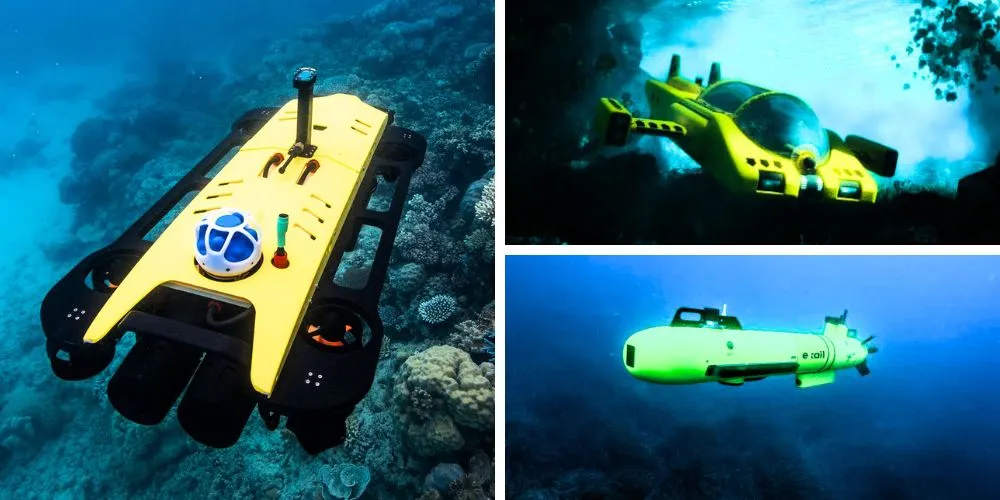Autonomous Underwater Vehicles (AUVs) have emerged as indispensable tools in oceanography, revolutionizing how scientists explore and understand the mysteries of the underwater world. This article delves into the expansive realm of AUVs, unveiling their significance, tracking the evolution of key technologies, examining diverse applications, and envisioning the transformative possibilities they hold for advancing our knowledge of the oceans.
The Significance of Autonomous Underwater Vehicles
Autonomous Underwater Vehicles play a pivotal role in ocean exploration by offering a versatile and autonomous means to investigate the depths of the oceans. The significance lies in their ability to conduct precise, long-duration missions in many oceanic environments, collecting valuable data for many scientific purposes.
Unparalleled Versatility and Autonomy
Autonomous underwater vehicles are designed to operate autonomously and free from direct human control, allowing them to navigate ocean depths with unparalleled versatility. This autonomy enables AUVs to cover vast areas, explore challenging terrains, and adapt to changing conditions, providing researchers with a comprehensive understanding of diverse underwater ecosystems.
Long-Duration and Uninterrupted Missions
Unlike traditional remotely operated vehicles (ROVs) that rely on surface support and tethers, AUVs can undertake long-duration missions independently. These vehicles can operate for extended periods, collecting continuous data and conducting surveys, making them ideal for studying dynamic oceanic processes and marine life behavior.
Precise Data Collection and Instrumentation
Equipped with various sensors and instruments, Autonomous Underwater Vehicles enable precise data collection in real-time. These instruments measure parameters such as temperature, salinity, pressure, and ocean currents, providing detailed insights into the underwater environment’s physical, chemical, and biological characteristics.
Evolution of Key Technologies in AUVs
The journey of Autonomous Underwater Vehicles is intricately woven with the evolution of key technologies that have continually expanded their capabilities and enhanced their performance in challenging underwater conditions.
Advanced Navigation and Positioning Systems
Modern Autonomous Underwater Vehicles have advanced navigation and positioning systems, including inertial navigation, acoustic positioning, and GPS technology. These systems ensure precise location tracking, allowing AUVs to navigate complex underwater terrains, follow predefined survey paths, and return to the surface accurately.
Energy-Efficient Propulsion Systems
Energy efficiency is a critical aspect of AUV design, and advancements in propulsion systems have played a pivotal role. AUVs often utilize energy-efficient thrusters or propellers and advanced battery technologies to optimize energy consumption and extend mission endurance.
Intelligent Control Algorithms and Machine Learning
Autonomous Underwater Vehicles leverage intelligent control algorithms and machine-learning techniques to adapt to dynamic environments. These technologies enable AUVs to make real-time decisions, avoid obstacles, optimize mission paths, and adjust behavior based on environmental conditions, enhancing their autonomy and operational efficiency.
Modular Payload and Sensor Integration
A key feature of Autonomous Underwater Vehicles is their ability to carry a variety of sensors and instruments tailored to specific research objectives. The development of modular payload systems allows researchers to customize AUVs for diverse applications, from mapping the seafloor to studying marine biology and monitoring underwater ecosystems.
Diverse Applications of AUVs in Oceanography
AUVs have diverse applications across various sub-disciplines of oceanography, contributing to advancements in marine research, environmental monitoring, and underwater exploration.
Seafloor Mapping and Geological Surveys
Autonomous Underwater Vehicles play a crucial role in seafloor mapping and geological surveys by capturing high-resolution images and 3D maps of the ocean floor. These vehicles enable researchers to study underwater topography, investigate geological features, and unravel the dynamic processes shaping the Earth’s crust.
Marine Biology and Biodiversity Studies
Marine biology researchers employ Autonomous Underwater Vehicles to study marine organisms’ biodiversity, behavior, and distribution. These vehicles can capture high-definition images and videos of underwater life, contributing to understanding ecosystems, species interactions, and the impacts of environmental changes.
Climate Change Research and Ocean Monitoring
AUVs are instrumental in climate change research by monitoring key indicators of ocean health. They collect data on temperature variations, ocean currents, and carbon flux, providing essential information for assessing the impacts of climate change on marine ecosystems and the global climate system.
Under-Ice Exploration and Polar Research
In polar regions, AUVs are utilized for under-ice exploration and polar research. These vehicles navigate beneath ice shelves to study ice-ocean interactions, measure ice thickness, and investigate polar ecosystems. AUVs contribute to our understanding of the effects of climate change in these critical regions.
Transformative Possibilities and Future Outlook
The trajectory of AUVs in ocean exploration points towards a future filled with continued innovation, integration, and unprecedented possibilities.
Deep-Sea Exploration and Extraterrestrial Analogs
AUVs equipped for deep-sea exploration may find applications in exploring extraterrestrial analogs, such as the subsurface oceans of icy moons like Europa and Enceladus. The technologies developed for AUVs could be adapted to navigate and study environments with similar challenges to those found in Earth’s deep oceans.
Collaborative AUV Networks and Swarm Robotics
The future of AUV exploration envisions collaborative networks and swarm robotics, where multiple AUVs work together to cover large ocean areas simultaneously. Collaborative AUV networks can optimize data collection, enhance mission efficiency, and provide a more comprehensive understanding of oceanic processes.
Underwater Archaeology and Cultural Heritage Preservation
AUVs have the potential to play a significant role in underwater archaeology and cultural heritage preservation. These vehicles can explore submerged archaeological sites, document underwater cultural heritage, and contribute to the protection and conservation of maritime heritage.
Conclusion
Autonomous Underwater Vehicles have redefined the landscape of ocean exploration, providing researchers with a powerful and autonomous tool to navigate the depths of the oceans. As we venture into the underwater realms with AUVs, the significance of these autonomous explorers is groundbreaking and essential. With continued research, technological advancements, and collaborative efforts, AUVs will remain at the forefront of oceanography, unlocking new possibilities, unraveling the oceans’ secrets, and contributing to the sustainable management of Earth’s aquatic ecosystems.










